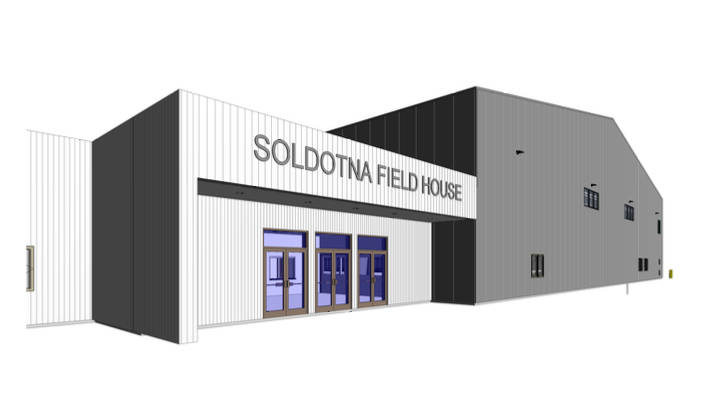Throughout 2017, the remodel the Soldotna Regional Sports Complex hasn’t been a sprint to the finish line, but progress on the proposed field house has been inching closer and closer to becoming a reality.
Tim Dillon, Executive Director of the Kenai Peninsula Economic Development District, has been leading the advisory team for the indoor field and recreational facility and said that the project will reach an important milestone in early 2018.
Currently, the architectural designs for the project are 65 percent done, Dillon said. The designs are being done by Burkhart Croft Architects, LLC of Anchorage.
“It’s great, and in the first quarter of next year we’re going to be at 95 percent drawn,” he said. “That’s a huge demarcation spot. It’s one of those goals you want to reach because then you can really go forward with some of the fundraising goals… Whenever you’re talking in the preliminary stages and asking people to write checks, they want to see something concrete. I think we’re getting there.”
This May, the Soldotna City Council voted to set aside $3 million for the project, should it come to fruition. The funds have not actually been spent and the city is not locked into spending the $3 million, but the promised funds can be used by the advisory team as a local match when searching for grant and donor funds, according to the ordinance text.
When discussing the ordinance in May, several council members expressed concerns about how the field house could impact the city’s finances down the road, especially in the face of Alaska’s budgetary concerns.
“If this were 10 or 12 years ago when the state was not in the position it’s in now, I think that I would very readily support this,” Murphy said at the May meeting. “The truth is that the state is having real fiscal problems … and all of us up here know that when the state needs money … they can pass things on down to local governments and make us responsible for more and more of the things that the state used to provide. And so I can see us taking a big hit in our budgets in the coming years because of the problems that the state is experiencing … and so I’m really reluctant to spend our reserves in the fund balance on something that is going to increase our subsidy to that facility.”
The ordinance passed, though, allowing the advisory committee to move forward.
They estimate that the project will cost between $7 and 11 million. The exact features of the field house depend on how much money is raised through fundraising and grants, on top of the $3 million already promised by the city.
“We were able to get the commitment from the council and then we just started moving forward,” Dillon said. “We hadn’t missed a step with some of the changes that have taken place and we’re looking forward to first quarter next year when we sit down with the entire council and walk through the parameters and questions.”
The committee is planning to make a presentation to the Soldotna City Council in the first quarter of next year, but is working closely with the council to avoid handing over a “white elephant,” Dillon said.
“We want to make sure that it’s going to be as productive a building as it can be. I want to make sure that it is truly multipurpose for all sports,” Dillon said. “Whether it’s wrestling, volleyball, soccer… people being able to practice certain aspects of baseball or softball. Even for people that want to be walking or jogging for their health.”
Throughout the process, plans and parameters for the remodel have shifted and have left the project with less space than originally anticipated but, according to Council Member Tim Cashman, the current design handled the changes well.
“I was pleasantly surprised with the really effective use of a smaller space,” Cashman said. “I thought to have this be successful for the community it would need to be the size of a full-sized soccer field, but they came up with other uses that fit so much better.”
Cashman said that the designs have created a true multi-sport facility, instead of just an indoor soccer field.
“It’s very expensive and we’re a long way away, but the work that has gone into it is really exciting,” Cashman said. “I was skeptical at first. I was concerned that if we didn’t have the money, it wouldn’t be worth it with a smaller space but I was pleasantly surprised… But the current designs, if we could get the money put forward, would be absolutely amazing the community.”
Dillon also said he is hopeful about the impact that the field house could have on quality of living on the Kenai Peninsula.
“You have all the outdoor things (on the peninsula) but there are certain times, especially with young people, where being able to be in an indoor facility in January and February when it’s a little bit chilly would really help,” Dillon said. “It’s a great opportunity and we look forward to waht 2018 is going to bring us.”
Reach Kat Sorensen at kat.sorensen@peninsulaclarion.com

